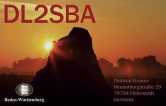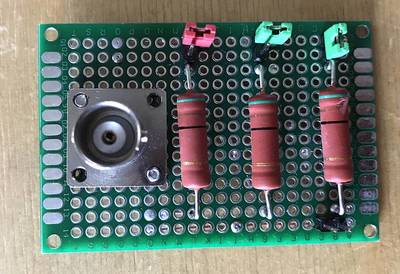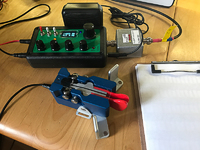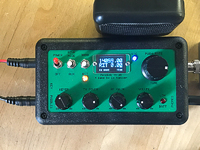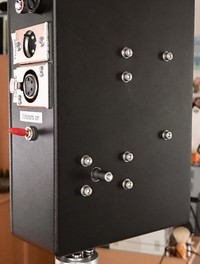A small SWR-Simulator for QRP tests. This tiny unit provides SWR values of 1:1, 2:1 and 3:1.
My new TR-35 QRP CW transceiver does not have a build-in tuner nor a build-SWR meter. My search for a very small and simple metering solution led me to the work of Martin, DK3IT.
His complete work can be found on GITHUB for download. As suggested on his site, I've ordered three tiny PCBs via OSHPARK - unbelievable that you can three PCBs including shipment to DL for €2,22.
Basics
Inspired from the work of EA4TX and K3NG I decided to check, whether the ESP8266 based NodeMCU 1.0 (ESP-12E) is usable as a simple remote IP-based rotator control. You can get the NodeMCU in a decent quality on eBay.
Idea was, to link a local emulated serial port to the NodeMCU module. The HAM Radio applications are communicating via the standard Yaesu GS232A protocol with the emulated serial port. This emulated serial port then forwards the serial requests to the NodeMCU.
Intro
I try to fix a HARDROCK-50 amplifier, which a fellow HAM bought second hand but it didn't really work.
Allgemein
Ich habe die Firmware für die Hamware Tuner um den Yaesu FT-991A erweitert.
In Verbindung mit den Logbuchprogrammen UCXLog und Swisslog folgt der Tuner automatisch der eingestellten Frequenz.
Nähere Infos sind hier zu finden.
I've developed a small interface board for the HAMWARe controller AT-502, AT-515 and AT-651B. This interface boards supports RS232 and CI-V communications and can be directly mounted into the controller chassis.
In this post I describe in details, how you can create the calibration factors for k0 ... k3 based on raw data measured with the power sensor.
Some quick measurements on a DK2DB balun.
New firmware for hamware AT-615B
I've developed firmware version supporting the AT-615B tuners from hamware.
You can find information in the manual for the AT-615B, which is identical in terms of usage.
Parts are available at cost price. Please check here.
Based on the work of Jan, DJ1JAN I've build some QRP-1:49 UNUNs.
My first experiences with this board on 20m using a FT82-44 core are, that the core gets hot at 5W on 20m / 14MHz.
Based on this experience I consulted the mini Ringkernrechner and and did some calculations. As far as I understand, the primary coil with 3 turns limits the maximum usable power.
Browsing the internet, I stumbled over an interesting video on YouTube were a guy shows a very cheap ESP32+camera solution to read the analog readout of water meters.
The software was developed by JomJol and provided on his Github repository. All you have to do is to buy an ESP32+camera module, flash the firmware und the SD-Card and then the water meter is read.
Inspired by the webpage of SARCNet, I decided to build the SARCNet MK1 rotator.
I started my journey into QO-100 with a very simple setup. Details can be found here. The previous setup consists of the well known LimeSDR-mini, a pre-amp and a modified WiFi-amp. No I placed all the components into an old case - not so fancy but sturdy.
Yesterday the IceConeFeed v2 from Patric - DC8PAT - arrived well-packed and preassembled with the Golden Media 202 LNB.
I started my journey into QO-100 with a very simple setup. Details can be found here. I used purely SDRConsole to receive & transmit audio via a simple USB headset. This was no real comfort and it was not capable transmitting CW ;-)
Fortunateley Andreas DL4JAL published 2021 in the German ham radio magazin FUNKAMATEUR an interesting hardware console. The basic idea behind this console is, that through the internal soundcard SSB-audio as well CW-audio can be transmitted. A hardware PTT key can used to switch SDRConsole into transmit mode. Furthermore it controls the timing for T/R-switching - SDRConsole has some delay between audio input and rf-output via the LimeSDR-mini - so no loss of last DIT or syllable.
Based on the publication of Matthias, DD1US, I bought from him one of these TMT H3930 isolators - Thanks Matthias for supporting the community!!!
My current setup to operate ES'hail & QO-100.
I received a new WLAN grid antenna from a fellow Ham - thanks for this!
My previously used pre-amplifier (the one in front of the final PA) only delivers a gain of abt. 9dB @2.4GHz. This was far too less for my final PA used.
